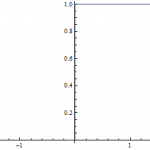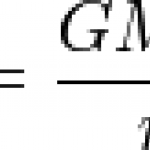
On the surface it's one of the most boring possible functions. Two straight horizontal lines: the Heaviside step function.
Usually denoted θ(x), it's equal to 0 if x is less than zero, and it's equal to one if x is greater than zero. At x = 0 exactly it doesn't really matter what it is for physics purposes so it's generally taken to be 1. Mathematicians tend to define it as 0.5 at x = 0, but they're kind of weird.
Believe it or not, there's some pretty good reasons for having the Heaviside function around. Walk into a dark room and flip on the lights. Before you hit the switch, the…
News from around the world of physics:
Near and dear to my heart is any clever experiment involving lasers. And via Swans on Tea, this one's a doozy. It's paddleball, but instead of a rubber ball you have a single atom. And instead of a paddle you have a beam of laser pulses. No string, so it's an extra challenge. Of all the esoteric ways people have devised to measure g, I think this one is the best.
Over at Uncertain Principles, Chad discusses science writing. Lots of it isn't very good, but he gives some excellent examples of the cream of the crop. Very, very far down my list of…
There was, if I am not mistaken, an episode of I Love Lucy wherein Lucy manages to get her head stuck in a metal teakettle. Ethel jokingly (I hope!) suggests that she put her head in the oven to heat up the metal so it will expand and she can fit her head out. A clever idea, not counting the fact that it would have unfortunate side effects for Lucy!
But we shouldn't be so convinced it would work. Consider a piece of sheet metal with a circular hole punched out. Heated, the metal expands. The hole will either get larger or smaller - does the overall expansion cause the metal to expand…
In full early-90s nostalgia mode, you skate down the street in your roller blades. Your thrill at the excitement of the open road distracts you, and one foot goes off the pavement into the soggy soil beside the road. That foot immediately slows down due to the drag and as a result of the difference in speed between the foot on the road and the foot on the dirt steers you right off the road where I hope you don't hurt yourself.
Refraction is the same thing, but with light.
Pass from one medium to another in which light travels at a different speed, and the light will bend. Students grumble…
Every section of Physics 218 I've taught this semester has asked me about this question. Really it's less of a physics question than it is a math question, but either way it gives people fits. It's not all that surprising. While it seems like it should be simple, to most beginning students it's not at all intuitive how all the given information gits together. Without further ado, the problem:
Earthquakes produce several types of shock waves. The most well-known are the P-waves and the S-waves. In the earth's crust, the P-waves travel around 8.9 km/s while the S-waves move at about 2.7 km/…
A little off the beaten path today, I'd like to present two poems by two physicists who were both on my Ten Greatest list. They're very different, one contemplative and loose in form, the other playful but more rigorous. It's an interesting comparison.
Untitled
Richard Feynman
There are the rushing waves...
mountains of molecules,
each stupidly minding its own business...
trillions apart
...yet forming white surf in unison.
Ages on ages...
before any eyes could see...
year after year...
thunderously pounding the shore as now.
For whom, for what?
...on a dead planet
with no life to entertain…
This one's from Young and Freedman, and I pick it out because it's both from the chapter I'm teaching and it's a great conceptual problem as well. (I've modified it slightly.)
A shotgun fires a large number of pellets upward, with some pellets traveling vertically and some as much a 1 degree from the vertical. Ignore air resistance and assume the pellets leave the gun at 150 m/s. Within what radius from the point of firing will the pellets land? Will air resistance tend to increase or decrease this number?
The book gives the range equation directly even though it can be derived easily, so…
Continuing my series of basic concepts with middle school math will be tricky when we're doing a Sunday Function. But let's give it a shot, and see if we can keep it to that beginning level.
This function is pretty simple. You add reciprocals until you get reach whatever number n you've picked, then you stop. Formally the function has a name - the harmonic series. As you pick bigger and bigger n, the sum will be bigger and bigger. There's no limit to how big it will get, but clearly its growth will be pretty slow. If you want f(n) = 100, n is going to have to be pretty stinking huge.…
And when he had opened the third seal, I heard the third beast say, Come and see. And I beheld, and lo a black horse; and he that sat on him had a pair of balances in his hand.
- Revelation 6:5
Well if everyone's going to talk about the financial crisis like it's the end of the world we might as well be literary about it.
The ScienceBlogs homepage has a somewhat panicky roundup of sciencebloggers who're looking for free cash concerned about the future of science in America. And all kidding aside, they've got a point. So far as I can see, there's three reasons to include a lot of science…
Continuing our "basic concepts with no math" series, here's one of the most important for quantum mechanics and statistical mechanics.
To start, imagine a billiards table. It has an assortment of billiard balls, each numbered and colored differently. You can imagine randomly knocking them around the table, sort of in analogy to gas molecules bouncing around a room. As we've discussed, it's very likely that on average the balls will be distributed more or less evenly around the table. You will rarely just happen to end up with all of them on one side of the table. By pure chance it might…
Ok, so yesterday wasn't quite as basic as I planned on shooting for in this week or two of working on non-mathematical concepts. But the idea was too cool to resist. This isn't exactly a mathematically elementary subject either, but the concept can be grasped without needing to see the actual functions involved.
This is a random sample of a large number of women, arranged by height:
There are many people of average height in the world, and a smaller number of very tall and very short people. The more extreme the height, the rarer the people with that height.
On the other hand, we could…
Standing on the edge of Niagra Falls you can watch the water pour over. Falling down the gravity of the earth, it exchanges its potential energy for kinetic energy by picking up speed. Some of that energy is extracted by turbines and lights the homes and businesses of Yankees and Canucks alike. Some of that energy is used to pump water up into water towers to maintain the water pressure which those same people use to cook and clean.
Move with a gravitational field, get energy. Move against it, lose energy.
Now let's say you wanted to take apart the earth. Yes, the whole thing. You want…
As a graduate student, you're an adult on your own. You have to find a place to live, food to eat, and a way to get around. Like most of the necessities of life, these things cost money. Where to get it?
There's three major options.
1. Teaching Assistantships. You are hired by the department in which you study to teach classes to the undergraduates. This is what I do now. In my case it requires about 9 hours of blackboard time a week, and another three or so grading and lesson planning. It's a lot of trouble and it doesn't pay all that well, but for a 12-14 hour/week job of fairly low…
Whew! Long weekend. Unfortunately, due to work/procrastination the post I wanted to write still isn't ready. But today I'm also teaching 1d accelerated motion to my Physics 218 students, and that's interesting of itself.
One of the things I try to do is give problems that help build instinct for what an answer should look like. If an accounting students calculates that a million-dollar-per-year business owes a billion dollars in taxes, he will instantly recognize that there's an error somewhere. You've got to built up the same kind of intuition in physics. Example:
The New Horizons…
First, a very quick and simple introduction to recursion. Here's an example. Pick a positive whole number n. The factorial function in the product of all the integers between 1 and n. For some reason it's denoted by an exclamation point.
Now if you compute 5!, you don't need to repeat the whole process if you want to compute 6!. You can just take the answer to 5! and multiply that by 6. Explicitly, because 5! = 1x2x3x4x5, that means 6! = 1x2x3x4x5x6 = (1x2x3x4x5)x6 = (5!)x6. Let me write this generally:
Now just keep that in the back of your mind for a moment and let me show you a…
[I'm foregoing the usual Saturday miscellany for a Very Special Built on Facts. It's important!]
Imagine a basketball sitting on the top of a hill. The slope of the hill is pretty gentle, and so you can roll the ball around a bit without the risk of it rolling away. But hit it too hard and it's going to catch the slope and zoom off. You and many of the materials which surround you are not so different. They're made of atoms which are comfortable so long as you don't hit them very hard. But hit them hard enough with oxygen molecules and they'll go flying away. And they'll hit other…
Yesterday I spend a tremendous amount of time in a very snazzy lab shooting lasers through pyridine. Cool stuff, tempered by the fact that pyridine smells like what Dr. Frankenstein's lab would have smelled like if Dr. Frankenstein used organic chemistry instead of electricity, and also the thing he was trying to bring back to life was a dead fish. Science waits for no man - not at least if you have a sensitive nose. Anyway, it resulted in my super-cool post about gravity not being done yet. Blarg! With any luck I'll have it up Monday.
So as something cool for the Built on Facts show…
The Second Law of Thermodynamics probably produces more confusion in the general public than most other physical laws that have percolated themselves into the collective consciousness. Not the least of these are all the seemingly disconnected ways of saying it, which vary in accuracy. Disorder increases. Absolute zero is impossible. Engines can't turn heat into work with perfect efficiency. Things fall apart, the center cannot hold, mere anarchy is loosed upon the world...
Well maybe not that last one.
Probably the version that both makes the most sense and is the most accurate is one…
Consider the turntable of an old record player. Or equivalently, a CD affixed to a player so that it may spin freely. We'll pretend there's no friction, though as always reality will manage to generate some. Now stretch your imagination a bit further and imagine that you shrink yourself down to a height of about 6 inches or so and stand on the turntable/CD. You look around, and having decided that now's as good a time as any to get started on your exercise routine, you start walking laps around the disc.
Conserving angular momentum, the surface will begin to rotate under you in the…
In the comments of yesterday's post about the output of the sun, Carl Brannen brought up a good point:
By the way, in comparing your audience to cows and compost heaps is there some sort of message here? It's been 25 years or so but I recall that there was a certain time of year around which I'd pretty much had my fill of grad school. The worst was towards the end of the 3rd quarter of a 3 quarter year. About that time, the Santa Anna winds reverse. The result is a wanderlust breeze off the ocean.
Aw Carl, you and the rest of my readers rock. I only mean that in terms of power output, the…











